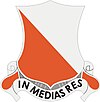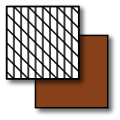Tenné
| Tenné | |
|---|---|
| Class | Stain |
| Non-heraldic equivalent | Orange, brown, orange-tawny colour |
| Monochromatic designations | |
| Hatching pattern | |
| Tricking abbr. | |
| Poetic designations | |
| Heavenly body | Dragon's tail |
| Jewel | Sardonyx |
In heraldry, tenné (/ˈtɛni/;[1][2] sometimes termed tenny[1] or tawny) is a "stain", or non-standard tincture, of orange (in English blazonry), light brown (in French heraldry) or orange-tawny (in continental heraldry) colour.[3]
Tenné, however, is not to be confused with brunâtre ("brownish") of French and German blazons.
- Difference between tenné & brunâtre
Tenné is used for the depiction of leather colour, while the much darker brunâtre is used for the depiction of bear hide colour.
Etymology
[edit]In the Oxford English Dictionary, tenné is described as "orange-brown, as a stain used in blazoning", and as a mid-16th-century variant of Old French tané.[1][2] The origin of both tenné and tawny is the Medieval Latin word tannare, meaning "to tan leather".[4] As such, in French (and most of continental) heraldry, tenné is the light-brownish colour that leather is supposed to have once tanned. Used primarily for depicting wood and skin in proper charges, it then slowly became its own tincture.
Hatchings
[edit]Perhaps as a symptom of the theoretical nature of heraldic stains, the hatchings assigned to these have been inconsistent among sources. The hatching for tenné has been given variously as a combination of vertical lines (as gules) and dexter to sinister lines (as vert),[5] or as a combination of horizontal lines (as azure) and sinister to dexter lines (as purpure),[6] (and other combinations may be found in other sources) though both these sources provide the same hatching of alternating vertical dots and dashes for "orange".[7]

Poetic meanings
[edit]In the system of poetic meanings, tenné is associated with the Dragon's tail and with the gemstone sardonyx.[8]
In theory and in practice
[edit]While tenné is frequently mentioned in books about heraldry, it is not among the basic heraldic colours and its appearance in practice is quite rare. Arthur Charles Fox-Davies, in his Complete Guide to Heraldry, asserted that both tenné and murrey were probably inventions of the theoretical (though never shown in actual practice) system of abatements, further commenting that he knew of only one instance of tenné to date (as of 1909), and that was in an estate livery rather than coat armory.[9] The Oxford Guide to Heraldry cites a late-14th century English treatise as stating that in addition to the two metals and five colours, a colour called tawny was "borne only in the Empire and France," the Oxford Guide also citing Gerard Leigh's The Accendance of Armory (1562) as rejecting tenné or tawny as non-existent and sanguine or murrey as mistaken purpure.[10]
In Britain
[edit]
Despite its role in the system of theoretical abatements of honour introduced in the 16th century,[11] tenné is quite rare in British armory, appearing only occasionally in liveries and never as a colour upon the escutcheon. The Oxford Guide to Heraldry notes that the "stains" (tenné, murrey and sanguine) "occur occasionally in the twentieth century but have never been spotted in a Visitation record."[12] Fox-Davies named the estate livery of Lord Fitzhardinge, worn by the lord's hunt servants, as the only known occurrence of "orange-tawny" in British armory.[13] To this, Woodward was able to add the standards of both the Earl of Derby, bearing the Stanley crest upon a field of tawny and vert, and the Earl of Northumberland, bearing "four horizontal bands, the upper being russet, the two central ones yellow, and the lowest tawny".[14] The Coat of arms of West Yorkshire (1975–1986) was supported on the sinister side by a lion per fess tenne and vert, with a lion per fess gules and tenne in crest.[15]
According to the Heraldry Society of Scotland, the team colours of the Dundee United Football Club should be called "tenny and argent".[16] Dundee United calls the colours tangerine and white, and the team is referred to as "the tangerines".[17]
In continental Europe
[edit]According to the Oxford Guide to Heraldry, a late-14th century English treatise on heraldry stated that a colour called tawny was "borne only in the Empire and France."[10] Fox-Davies suggested that orange, as it appears in German heraldry, may be a different colour than tenné, noting that a different hatching is associated with German orange than that of British tenné.[18] German heraldic author Ottfried Neubecker also noted a distinction between orange and brown or tenné, showing the usual hatching for tenné but a distinctive hatching of alternating vertical dots and dashes for orange.[19] Orangé, tanné and tenné appear in the civic arms of several communes in the Department of Oise in France.[20]
In French heraldry, tanné (same as tenné) is traditionally a light brown. It is to be a light brown colour, bright enough to be distinguished from the darkest heraldic colour, sable (black), as well as the darker brown color brunâtre, used for bear hide fur. It should also be a distinctive brown, and be clearly different than both flesh-color carnation and orangé, used per example as the field color for the arms of the French commune of Lamorlaye. Tenné takes its name from the colour of tanned leather,[21] and occurs in the field of the arms of a few French communes, including Maruéjols-lès-Gardon.[22] Tanné colour also occurs in the dexter chief quarter of the arms of La Neuville-Roy, where it notably replaces azure as the field for a semy of fleurs-de-lys very reminiscent of the ancient arms of France.
In English heraldry, all these colours are sometimes—yet mistakenly—confused as tenné.
-
Arms of the French city of Maruéjols-lès-Gardon, bearing a field tenné
-
Arms of the French commune of La Neuville-Roy, bearing a field tanné in the dexter chief quarter.
In Australia
[edit]
Granted in 1978, the Coat of arms of the Northern Territory has a tenny field, with a design inspired by Aboriginal paintings.[23]
In South Africa
[edit]
Orange is a common colour in South African heraldry, because of the history of South Africa as a Dutch colony, and the fact that royal house of the Netherlands is the House of Orange. The Dutch Prince's Flag was an orange white and blue tricolour, and this was the basis of the flags of the Orange Free State (1857-1902) and the Union of South Africa (1928-1994).
In the United States
[edit]
Tenné (so blazoned) is found in the arms and colours of some U.S. military units, particularly in the Signal Corps, where the colour is shown as a bright shade of orange, and the Cavalry, where tenné is sometimes called "dragoon yellow".
The coat of arms of the 1st Signal Battalion, designed in 1932 by the U.S. Army Heraldic Program Office (since 1960 called the Institute of Heraldry) is per bend argent and tenné, since orange and white are the traditional colours of the Signal Corps.[24] These colours are repeated in the arms of virtually every battalion in the Signal Corps.[25]
The 1st Cavalry Regiment (also known as the 1st Regiment of Dragoons) was assigned a coat of arms by the Heraldic Program Office in 1921 featuring a gold dragon on a field of tenné. The 1st Cavalry was founded as the Regiment of United States Dragoons in 1833, and at the time the dragoon units wore a cord of tenné (which they called "dragoon yellow") and Or (gold). These are also the colours of the torse in the coat of arms of the unit.[26]
In popular culture
[edit]The Star Trek Star Fleet Technical Manual describes the official tunic color of Star Fleet Command Section standard issue uniforms, such as those worn by James Kirk and Hikaru Sulu, as "tenne".[27] These are the tunics depicted on the actual show as yellow-gold fabric. Separate from this, officers of Captain's rank or higher may optionally wear tunics and dress uniforms greenish in hue; the Manual specifies this color as "olive."
Examples
[edit]-
#86401A Brunâtre with hatching
-
#806E38 (left) Continental and #F08800 (right) English tenné
-
#FF6600 Orange with hatching
See also
[edit]References
[edit]- ^ Jump up to: a b c "Tenné". Oxford US English Dictionary. Oxford: Oxford University Press. Archived from the original on May 7, 2013. Retrieved 2015-10-06.
- ^ Jump up to: a b "Tenné". Oxford British & World English Dictionary. Oxford: Oxford University Press. Archived from the original on August 3, 2012. Retrieved 2013-04-29.
- ^ Arthur Charles Fox-Davies, A Complete Guide to Heraldry London: T. C. and E. C. Jack, 1909, p. 72, uses orange and tenné synonymously and in the next sentence defines tenné as "an orange-tawny colour". Leigh, as quoted by Woodcock & Robinson, on p. 52, defines tenne as "orenge colour"[sic]. Neubecker, on p. 86, on the other hand, equates tenné with brown, as distinct from orange.
- ^ "Tan". Oxford Dictionaries. Oxford: Oxford University Press. Archived from the original on May 6, 2013. Retrieved 2013-04-29.
- ^ Neubecker, p. 86.
- ^ Fox-Davies, p. 76.
- ^ Confer both previous citations (Neubecker, p. 86 and Fox-Davies, p. 76).
- ^ Woodward, John; Burnett, George (1892). A Treatise on Heraldry, British and Foreign. Vol. 1. Edinburgh / London: W. A. K. Johnston. p. 65.
- ^ Fox-Davies, Arthur Charles; Graham Johnston (2004) [1909]. A Complete Guide to Heraldry. Kessinger Publishing. pp. 72–73. ISBN 1-4179-0630-8.
- ^ Jump up to: a b Woodcock, Thomas; Robinson, John Martin (1988). The Oxford Guide to Heraldry. Oxford: Oxford University Press. p. 51. ISBN 0-19-211658-4.
- ^ Woodcock & Robinson, p. 68.
- ^ Woodcock & Robinson, p. 53.
- ^ Fox-Davies, p. 73.
- ^ Woodward, John (1896). A Treatise on Heraldry, British and Foreign. Edinburgh and London: W. & A. K. Johnston. pp. 185, 305.
tawny.
- ^ "West Yorkshire County Council". Civic Heraldry of England and Wales. Retrieved 2013-05-10.
- ^ Dennis, M. D. (1999). Scottish heraldry: an invitation. Edinburgh: Heraldry Society of Scotland. p. 23.
- ^ "History - 50s & 60s". www.dundeeunitedfc.co.uk. Archived from the original on 2013-10-06. Retrieved 2013-04-30. Dundee United states the colour was borrowed from an American team called Dallas Tornado in the 1960s.
- ^ Fox-Davies, p. 74.
- ^ Neubecker, Ottfried (1976). Heraldry: Sources, Symbols and Meaning. Maidenhead, England: McGraw-Hill. p. 86. ISBN 0-07-046308-5.
NB: The same hatching Neubecker gave for "orange" was repeated in Fox-Davies, p. 76, as the hatching for German "orange". - ^ Specifically, the arms of Lamorlaye have a field tinctured orangé (in French), the arms of Margny-lès-Compiègne have a divided field which is partly tinctured orangé as well as a charge in chief which is also orangé, and the arms of La Neuville-Roy has a quarter tinctured tanné (in French); all of these are communes in the Department of Oise; see them listed at Armorial of the Communes of Oise-3 (I-P).
- ^ Joubert, Pierre, Nouveau guide de l'héraldique (1984), Rennes, Ouest-France.
- ^ Le Grand Robert de la Langue Française, (2001).
- ^ Northern Territory Flags & Emblems, About Australia, Retrieved 3 October 2015
- ^ Jump up to: a b "1st Signal Battalion". The Institute of Heraldry. Retrieved 2013-05-03.
- ^ For a full listing of the arms of each unit in the U.S. Army Signal Corps, see The Institute of Heraldry: Categories>Signal.
- ^ "1st Cavalry Regiment". The Institute of Heraldry. Archived from the original on 2013-09-21. Retrieved 2013-04-30.
- ^ "Star Fleet Technical Order – Duty Uniform – Male". Retrieved 2015-06-25.








